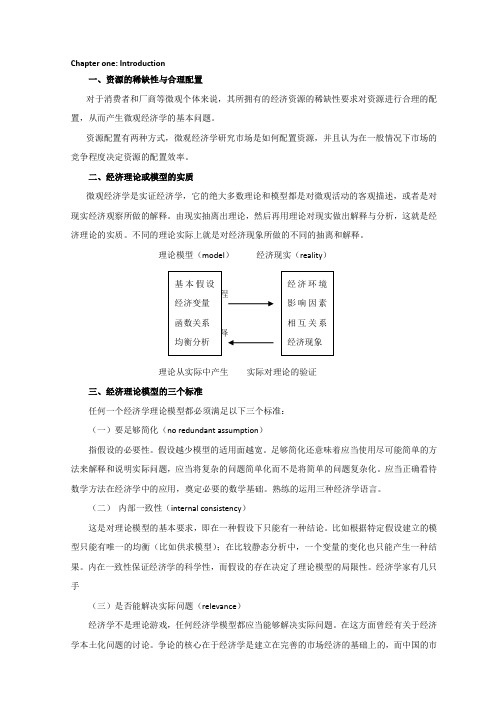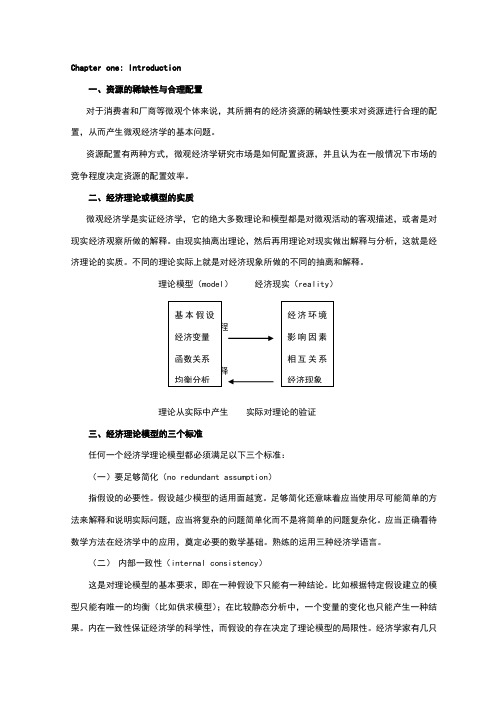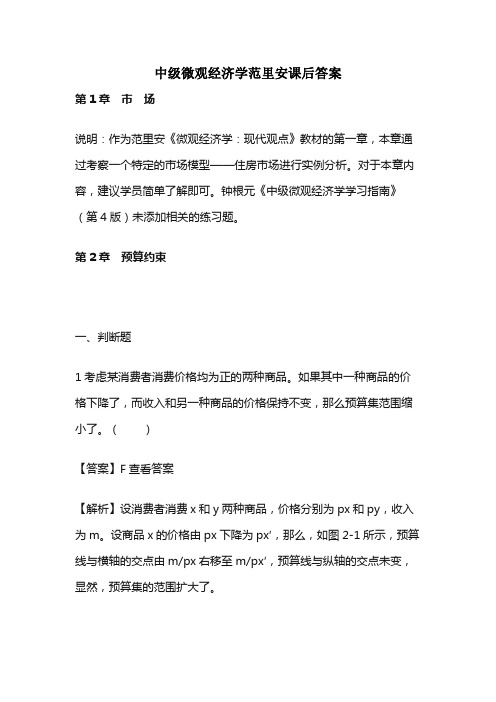范里安 微观经济学:现代观点(第一章)
范里安《微观经济学:现代观点》(第9版)笔记和课后习题详解

范里安《微观经济学:现代观点》(第9版)第一章复习笔记第1章市场1.1 复习笔记1最优化和均衡在分析人类的行为时,需要有一种作为分析基础的框架。
在多数经济学中使用的是一种建立在以下两个简单原理上的框架:(1)最优化原理:人们总是选择他们能够支付得起的最佳消费方式。
(2)均衡原理:狭义地讲,均衡就是在市场中需求方和供给方在市场机制的充分调整下达到的稳定状态,在该状态下价格是相对稳定的。
价格会自行调整,直到人们的需求数量与供给数量相等。
2需求曲线和供给曲线(1)保留价格某人为他消费的第i个单位的商品所愿意支付的最高价格称为保留价格。
或者说,一个人的保留价格是他对于买或不买有关商品并不在乎的价格。
(2)个人需求曲线如果用纵轴表示价格,横轴表示商品数量,对第i单位的商品,假设消费者愿意支付的保留价格是r i,于是在价格-商品坐标图上,标出对应的点(Q i,r i),把所有的点连起来就得到了需求曲线(这是一条折线),如图1-1所示。
图1-1 离散物品的需求曲线(3)市场需求曲线把整个市场上所有的消费者的个人需求水平加总后,就可以得到市场需求曲线。
通常,由于整个市场上的消费者非常多,而且每个消费者的保留价格也不完全一样,但是相互之间保留价格很接近,所以加总后的需求曲线是比较光滑的,如图1-2所示。
图1-2 市场需求曲线(4)市场供给曲线对于任意给定的价格,每个厂商都愿意供给一定的商品数量,把单个厂商的供给曲线水平加总就可以得到市场供给曲线。
3均衡市场(1)竞争市场该市场中有许多独立的消费者和商品的供应者,市场价格与每家厂商的产量无关。
(2)市场均衡当商品的供给等于需求时,市场达到均衡。
从图形上来看,就是供给曲线和需求曲线相交,交点对应的分别是均衡价格和均衡产量。
4比较静态分析比较静态分析就是分析已知条件变化后经济现象均衡状态的相应变化,以及有关经济变量达到新的均衡状态时的相应变化。
比较静态分析只对两个“静态”均衡做比较,而不关心市场从一种均衡状态达到另一种均衡状态的过程如何,即对经济现象有关的经济变量一次变动而不是连续变动的前后进行分析。
范里安-微观经济学现代观点讲义(new)

Chapter one: Introduction一、资源的稀缺性与合理配置对于消费者和厂商等微观个体来说,其所拥有的经济资源的稀缺性要求对资源进行合理的配置,从而产生微观经济学的基本问题。
资源配置有两种方式,微观经济学研究市场是如何配置资源,并且认为在一般情况下市场的竞争程度决定资源的配置效率。
二、经济理论或模型的实质微观经济学是实证经济学,它的绝大多数理论和模型都是对微观活动的客观描述,或者是对现实经济观察所做的解释。
由现实抽离出理论,然后再用理论对现实做出解释与分析,这就是经济理论的实质。
不同的理论实际上就是对经济现象所做的不同的抽离和解释。
理论模型〔model〕经济现实〔reality〕理论从实际中产生实际对理论的验证三、经济理论模型的三个标准任何一个经济学理论模型都必须满足以下三个标准:〔一〕要足够简化〔no redundant assumption〕指假设的必要性。
假设越少模型的适用面越宽。
足够简化还意味着应当使用尽可能简单的方法来解释和说明实际问题,应当将复杂的问题简单化而不是将简单的问题复杂化。
应当正确看待数学方法在经济学中的应用,奠定必要的数学基础。
熟练的运用三种经济学语言。
(二)内部一致性〔internal consistency〕这是对理论模型的基本要求,即在一种假设下只能有一种结论。
比方根据特定假设建立的模型只能有唯一的均衡〔比方供求模型〕;在比较静态分析中,一个变量的变化也只能产生一种结果。
内在一致性保证经济学的科学性,而假设的存在决定了理论模型的局限性。
经济学家有几只手?〔三〕是否能解决实际问题〔relevance〕经济学不是理论游戏,任何经济学模型都应当能够解决实际问题。
在这方面曾经有关于经济学本土化问题的讨论。
争论的核心在于经济学是建立在完善的市场经济的基础上的,而中国的市场经济是不完善的,因此能不能运用经济学的理论体系和方法来研究和解决中的问题。
两种观点:一种观点认为经济理论是一个参照系,可以用来比照和发现问题,因此具有普遍的适用性;另一种观点认为中国有自己的国情,需要对经济学进行改造或者使之本土化,甚至有人提出要建立有中国特色的经济学体系。
范里安,微观经济学现代观点讲义

Chapter one: Introduction一、资源的稀缺性与合理配置对于消费者和厂商等微观个体来说,其所拥有的经济资源的稀缺性要求对资源进行合理的配置,从而产生微观经济学的基本问题。
资源配置有两种方式,微观经济学研究市场是如何配置资源,并且认为在一般情况下市场的竞争程度决定资源的配置效率。
二、经济理论或模型的实质微观经济学是实证经济学,它的绝大多数理论和模型都是对微观活动的客观描述,或者是对现实经济观察所做的解释。
由现实抽离出理论,然后再用理论对现实做出解释与分析,这就是经济理论的实质。
不同的理论实际上就是对经济现象所做的不同的抽离和解释。
理论模型(model)经济现实(reality)理论从实际中产生实际对理论的验证三、经济理论模型的三个标准任何一个经济学理论模型都必须满足以下三个标准:(一)要足够简化(no redundant assumption)指假设的必要性。
假设越少模型的适用面越宽。
足够简化还意味着应当使用尽可能简单的方法来解释和说明实际问题,应当将复杂的问题简单化而不是将简单的问题复杂化。
应当正确看待数学方法在经济学中的应用,奠定必要的数学基础。
熟练的运用三种经济学语言。
(二)内部一致性(internal consistency)这是对理论模型的基本要求,即在一种假设下只能有一种结论。
比如根据特定假设建立的模型只能有唯一的均衡(比如供求模型);在比较静态分析中,一个变量的变化也只能产生一种结果。
内在一致性保证经济学的科学性,而假设的存在决定了理论模型的局限性。
经济学家有几只手?(三)是否能解决实际问题(relevance)经济学不是理论游戏,任何经济学模型都应当能够解决实际问题。
在这方面曾经有关于经济学本土化问题的讨论。
争论的核心在于经济学是建立在完善的市场经济的基础上的,而中国的市场经济是不完善的,因此能不能运用经济学的理论体系和方法来研究和解决中的问题。
两种观点:一种观点认为经济理论是一个参照系,可以用来对比和发现问题,因此具有普遍的适用性;另一种观点认为中国有自己的国情,需要对经济学进行改造或者使之本土化,甚至有人提出要建立有中国特色的经济学体系。
范里安_微观经济学现代观点讲义(new)

Chapter one: Introduction一、资源的稀缺性与合理配置对于消费者和厂商等微观个体来说,其所拥有的经济资源的稀缺性要求对资源进行合理的配置,从而产生微观经济学的基本问题。
资源配置有两种方式,微观经济学研究市场是如何配置资源,并且认为在一般情况下市场的竞争程度决定资源的配置效率。
二、经济理论或模型的实质微观经济学是实证经济学,它的绝大多数理论和模型都是对微观活动的客观描述,或者是对现实经济观察所做的解释。
由现实抽离出理论,然后再用理论对现实做出解释与分析,这就是经济理论的实质。
不同的理论实际上就是对经济现象所做的不同的抽离和解释。
理论模型(model)经济现实(reality)理论从实际中产生实际对理论的验证三、经济理论模型的三个标准任何一个经济学理论模型都必须满足以下三个标准:(一)要足够简化(no redundant assumption)指假设的必要性。
假设越少模型的适用面越宽。
足够简化还意味着应当使用尽可能简单的方法来解释和说明实际问题,应当将复杂的问题简单化而不是将简单的问题复杂化。
应当正确看待数学方法在经济学中的应用,奠定必要的数学基础。
熟练的运用三种经济学语言。
(二)内部一致性(internal consistency)这是对理论模型的基本要求,即在一种假设下只能有一种结论。
比如根据特定假设建立的模型只能有唯一的均衡(比如供求模型);在比较静态分析中,一个变量的变化也只能产生一种结果。
内在一致性保证经济学的科学性,而假设的存在决定了理论模型的局限性。
经济学家有几只手(三)是否能解决实际问题(relevance)经济学不是理论游戏,任何经济学模型都应当能够解决实际问题。
在这方面曾经有关于经济学本土化问题的讨论。
争论的核心在于经济学是建立在完善的市场经济的基础上的,而中国的市场经济是不完善的,因此能不能运用经济学的理论体系和方法来研究和解决中的问题。
两种观点:一种观点认为经济理论是一个参照系,可以用来对比和发现问题,因此具有普遍的适用性;另一种观点认为中国有自己的国情,需要对经济学进行改造或者使之本土化,甚至有人提出要建立有中国特色的经济学体系。
范里安_微观经济学现代观点讲义(new)

Chapter one: Introduction一、资源的稀缺性与合理配置对于消费者和厂商等微观个体来说,其所拥有的经济资源的稀缺性要求对资源进行合理的配置,从而产生微观经济学的基本问题。
资源配置有两种方式,微观经济学研究市场是如何配置资源,并且认为在一般情况下市场的竞争程度决定资源的配置效率。
二、经济理论或模型的实质微观经济学是实证经济学,它的绝大多数理论和模型都是对微观活动的客观描述,或者是对现实经济观察所做的解释。
由现实抽离出理论,然后再用理论对现实做出解释与分析,这就是经济理论的实质。
不同的理论实际上就是对经济现象所做的不同的抽离和解释。
理论模型(model)经济现实(reality)理论从实际中产生实际对理论的验证三、经济理论模型的三个标准任何一个经济学理论模型都必须满足以下三个标准:(一)要足够简化(no redundant assumption)指假设的必要性。
假设越少模型的适用面越宽。
足够简化还意味着应当使用尽可能简单的方法来解释和说明实际问题,应当将复杂的问题简单化而不是将简单的问题复杂化。
应当正确看待数学方法在经济学中的应用,奠定必要的数学基础。
熟练的运用三种经济学语言。
(二)内部一致性(internal consistency)这是对理论模型的基本要求,即在一种假设下只能有一种结论。
比如根据特定假设建立的模型只能有唯一的均衡(比如供求模型);在比较静态分析中,一个变量的变化也只能产生一种结果。
内在一致性保证经济学的科学性,而假设的存在决定了理论模型的局限性。
经济学家有几只手(三)是否能解决实际问题(relevance)经济学不是理论游戏,任何经济学模型都应当能够解决实际问题。
在这方面曾经有关于经济学本土化问题的讨论。
争论的核心在于经济学是建立在完善的市场经济的基础上的,而中国的市场经济是不完善的,因此能不能运用经济学的理论体系和方法来研究和解决中的问题。
两种观点:一种观点认为经济理论是一个参照系,可以用来对比和发现问题,因此具有普遍的适用性;另一种观点认为中国有自己的国情,需要对经济学进行改造或者使之本土化,甚至有人提出要建立有中国特色的经济学体系。
中级微观经济学范里安课后答案

中级微观经济学范里安课后答案第1章市场说明:作为范里安《微观经济学:现代观点》教材的第一章,本章通过考察一个特定的市场模型——住房市场进行实例分析。
对于本章内容,建议学员简单了解即可。
钟根元《中级微观经济学学习指南》(第4版)未添加相关的练习题。
第2章预算约束一、判断题1考虑某消费者消费价格均为正的两种商品。
如果其中一种商品的价格下降了,而收入和另一种商品的价格保持不变,那么预算集范围缩小了。
()【答案】F查看答案【解析】设消费者消费x和y两种商品,价格分别为px和py,收入为m。
设商品x的价格由px下降为px′,那么,如图2-1所示,预算线与横轴的交点由m/px右移至m/px′,预算线与纵轴的交点未变,显然,预算集的范围扩大了。
图2-1 价格下降引起的预算集变化2以横轴代表商品1,纵轴代表商品2,商品1价格为p1,商品2价格为p2,那么预算线的斜率为-p2/p1。
()【答案】F查看答案【解析】如图2-2所示,预算线的斜率k=-OA/OB,A为预算线与纵轴的交点,表示的是收入全部用于购买商品2时的消费量,即OA =m/p2,同理,OB=m/p1,因此预算线的斜率为k=-(m/p2)/(m/p1)=-p1/p2。
图2-2 预算线3如果所有的商品价格都变为原来的两倍,而收入保持不变,那么预算集没有变化,因为相对价格没有变化。
()【答案】F查看答案【解析】预算线方程为px+py=I,价格变为原来的两倍后,预算线变为2px+2py=I,或者px+py=I/2,显然,预算线斜率不变,但预算集范围缩小了。
4考虑两种商品,如果一种商品价格为正,而另一种商品价格为负(例如把“拾垃圾”也看成是“商品”,负的价格表示对消费者的补贴),那么预算线斜率为正。
()【答案】T查看答案【解析】预算线的斜率为k=-p1/p2,若一种商品价格为正,另一种商品价格为负,那么-p1/p2>0,即预算线斜率为正。
5如果所有商品价格变为原来的两倍,收入变为原来的三倍,则预算线会更加陡峭。
范里安《微观经济学:现代观点》第1章 市场—课后习题详解

相应的需求曲线如图 1-4 所示。
图 1-4
租赁房屋的需求曲线
2.在第 1 题中,假如只有 24 套住房可以出租,均衡价格是多少?如果有 26 套住房可 出租,均衡价格又是多少?如果有 25 套住房可出租,均衡价格是多少? 答: (1)假如只有 24 套住房可以出租,那么均衡价格为 500 美元。这是因为:均衡时, 供给曲线和需求曲线相交,交点的纵坐标对应的就是均衡价格,如图 1-5 的 A 点所示。特别 的,图 1-5 中的需求曲线和图 1-4 相同。 (2)如果市场上有 26 套住房出租,均衡价格为 0 美元(含)到 200 美元(含)之间的 任意数值。理由同(1) ,如图 1-5 的 C 点所示。 (3)如果只有 25 套住房可以出租,均衡价格为 200 美元(含)到 500 美元(含)之间 的任意数值。理由同(1) ,如图 1-5 的 B 点所示。
更多资料加 QQ 咨询:3179085483
区居民,因此需求减少了,需求曲线由 D 向左移至 D 位置,但同时内城区的住房供给也减 少了,而且因为每一个公寓由两套住房构成,所以供给的减少幅度大于需求的减少幅度,供 给曲线由 S 向左移动至 S 。新的均衡价格 P 高于原来的均衡价格 P 。
图 1-7
供给减少的幅度大于需求减少的幅度
更多资料加 QQ 咨询:3179085483
更多资料真题、 院校信息、 专业咨询、 名师讲座、 学长分享扫码加群
图 1-5
租赁房屋的供给和需求
3.假定人们持有不同的保留价格,为什么市场需求曲线向下倾斜? 答:保留价格是指对消费者而言,在此价格水平上,购买与不购买某一单位的产品是无 差异的,它是消费者愿意为该商品支付的最高价格。在此价格之上,消费者选择不购买,在 此价格之下,购买对消费者而言是有利的。 假定消费者持有不同的保留价格,对于某一特定的价格 p ,只有保留价格高于或等于 p 的消费者会购买有关商品,而保留价格低于 p 的消费者选择不购买。价格 p 越高,保留价格 大于 p 的消费者也越少;当价格 p 降低时,保留价格大于或等于 p 的消费者逐渐增多,购买 的也就越多。因此,当价格 p 下降时,市场需求会不断增加。当消费者足够多,互相之间保 留价格很接近的时候,市场需求线变成了一条光滑的向下倾斜的曲线。 4. 在书中, 假定原来公寓购买者都是来自内城区的人——那些已经在内城区租房的人, 如果现在公寓购买者都是来自外城区的人——那些目前没有在内城区租房的人,内城区住 房的价格会发生什么样的变化呢? 答:如果公寓被出售给非内城区居民,该内城区的房屋租赁价格会上涨。这是因为此时 房屋的供给减少,但需求不变(内城区的居民没有人购买房屋) ,所以新的供给曲线 S 2 与原 来的需求曲线 D1 的交点对应的价格上涨,如图 1-6 所示。
范里安《微观经济学:现代观点》(第9版)笔记和课后习题详解

范里安《微观经济学:现代观点》(第9版)第一章复习笔记第1章市场1.1 复习笔记1最优化和均衡在分析人类的行为时,需要有一种作为分析基础的框架。
在多数经济学中使用的是一种建立在以下两个简单原理上的框架:(1)最优化原理:人们总是选择他们能够支付得起的最佳消费方式。
(2)均衡原理:狭义地讲,均衡就是在市场中需求方和供给方在市场机制的充分调整下达到的稳定状态,在该状态下价格是相对稳定的。
价格会自行调整,直到人们的需求数量与供给数量相等。
2需求曲线和供给曲线(1)保留价格某人为他消费的第i个单位的商品所愿意支付的最高价格称为保留价格。
或者说,一个人的保留价格是他对于买或不买有关商品并不在乎的价格。
(2)个人需求曲线如果用纵轴表示价格,横轴表示商品数量,对第i单位的商品,假设消费者愿意支付的保留价格是r i,于是在价格-商品坐标图上,标出对应的点(Q i,r i),把所有的点连起来就得到了需求曲线(这是一条折线),如图1-1所示。
图1-1 离散物品的需求曲线(3)市场需求曲线把整个市场上所有的消费者的个人需求水平加总后,就可以得到市场需求曲线。
通常,由于整个市场上的消费者非常多,而且每个消费者的保留价格也不完全一样,但是相互之间保留价格很接近,所以加总后的需求曲线是比较光滑的,如图1-2所示。
图1-2 市场需求曲线(4)市场供给曲线对于任意给定的价格,每个厂商都愿意供给一定的商品数量,把单个厂商的供给曲线水平加总就可以得到市场供给曲线。
3均衡市场(1)竞争市场该市场中有许多独立的消费者和商品的供应者,市场价格与每家厂商的产量无关。
(2)市场均衡当商品的供给等于需求时,市场达到均衡。
从图形上来看,就是供给曲线和需求曲线相交,交点对应的分别是均衡价格和均衡产量。
4比较静态分析比较静态分析就是分析已知条件变化后经济现象均衡状态的相应变化,以及有关经济变量达到新的均衡状态时的相应变化。
比较静态分析只对两个“静态”均衡做比较,而不关心市场从一种均衡状态达到另一种均衡状态的过程如何,即对经济现象有关的经济变量一次变动而不是连续变动的前后进行分析。
- 1、下载文档前请自行甄别文档内容的完整性,平台不提供额外的编辑、内容补充、找答案等附加服务。
- 2、"仅部分预览"的文档,不可在线预览部分如存在完整性等问题,可反馈申请退款(可完整预览的文档不适用该条件!)。
- 3、如文档侵犯您的权益,请联系客服反馈,我们会尽快为您处理(人工客服工作时间:9:00-18:30)。
pe
pmax
Excess demand
100
QD,QS
Value Judgement (价值判断)
Which
of the following is better? – Rent control – Perfect competition – Monopoly – Discriminatory monopoly But, what do you mean by “better”?
pe 100
QD,QS
Comparative Statics (静态比较分析)
What
is exogenous in the model? – price of distant apartments – quantity of close apartments – incomes of potential renters. What happens if these exogenous variables change? Note: We are not analyzing the transition process or dynamic process.
Middle price
100
QD,QS
Imperfectly Competitive Market Case 2: Perfectly Discriminatory Monopolistic Landlord
Imagine
the monopolist knew everyone’s willingness-to-pay. Charge $500 to the most willing-topay, charge $490 to the 2nd most willingto-pay, etc.
Modeling Apartment Demand
Demand:
Suppose the most any one person is willing to pay to rent a close apartment is $500/month. Then p = $500 QD = 1. Suppose the price has to drop to $490 before a 2nd person would rent. Then p = $490 QD = 2.
Taxation Policy Analysis
Market
supply is unaffected. Market demand is unaffected. So the competitive market equilibrium is unaffected by the tax. Price and the quantity of close apartments rented are not changed. Landlords pay all of the tax.
Competitive Market Equilibrium
p
People willing to pay pe for close apartments get close apartments. People not willing to pay pe for close apartments get distant apartments.
p
p1 =$500 p2 =$490 p3 =$475
12 3
100
QD,QS
Discriminatory Monopolistic Market Equilibrium
p
p1 =$500 p2 =$490 p3 =$475
12 3
100
QD,QS
Discriminatory Monopolistic Market Equilibrium
p
p1 =$500 p2 =$490 p3 =$475 Discriminatory monopolist charges the competitive market price to the last renter, and rents the competitive quantity of close apartments.
The Purpose of an Economic Model
The purpose of an economic model is to help provide precise insights (精 确的洞察力)on a specific economic phenomenon. Thus: – Different phenomena needs different model; – Simplification by assumption is necessary
An Illustration: Modeling the Apartment Market
Purpose:
How are apartment rents determined? Are rents “desirable”? Simplifying assumptions: – apartments are close or distant, but otherwise identical – distant apartments rents are exogenous (外生变量) and known – many potential renters and landlords
Market Equilibrium
p
Higher demand causes higher market price; same quantity traded.
pe
100
QD,QS
More Comparative Statics (Do Them Yourself)
Suppose
there were more close apartments. Or, renters’ ing Apartment Demand
The
lower is the rental rate p, the larger is the quantity of close apartments demanded p QD . The quantity demanded vs. price graph is the market demand curve for close apartments.
Two Very Common Modeling Assumptions
– Rational Choice (理性选择): Each person tries to choose the best alternative available to him or her. – Equilibrium (均衡): economic agents interact with each other, resulting in an equilibrium, in which each person reaches an optimal decision given others’ decisions.
Chapter One
The Market --- Appreciating Economic Modeling
The Purpose of this Chapter
To
begin to understand the art of building an economic model To begin to understand three basic elements of modeling in economics: – Purpose – Simplification through assumptions – Value judgment
Imperfectly Competitive Market Case 1: A Monopolistic Landlord
Landlord
sets a rental price p he rents D(p) apartments. Revenue = pD(p). He chooses p to maximizes p D(p), subject to D(p) <= S (total number of apartments in his hands) Typically, his optimal p is such that D(p) < S, that is, there are vacant apartments.
pe
12 3
100
QD,QS
Rent Control (房租管制)
Local
government imposes a maximum legal price, pmax < pe, the competitive price.
Market Equilibrium
p
The 100 close apartments are no longer allocated by willingness-to-pay (lottery, lines, large families first?).
Market Supply Curve for Apartments
p
100
QS
Competitive Market Equilibrium (竞争性市场均衡)
Quantity
demanded = quantity available price will neither rise nor fall so the market is at a competitive equilibrium.
Pareto Efficiency (帕累托效率)
